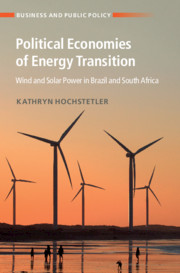Book contents
- Political Economies of Energy Transition
- Business and Public Policy
- Political Economies of Energy Transition
- Copyright page
- Contents
- Figures
- Tables
- Acknowledgments
- Abbreviations
- 1 Political Economies of Energy Transition in Brazil and South Africa
- 2 Wind and Solar Power in the Transition to a Low-Carbon Economy
- 3 States, Markets, and Energy Transition: Good Industrial Policy?
- 4 Electricity Consumption in Brazil and South Africa: Distribution and Prices
- 5 People and Place: Siting Wind and Solar Plants in Brazil and South Africa
- 6 Political Economies of Energy Transition
- References
- Index
2 - Wind and Solar Power in the Transition to a Low-Carbon Economy
Published online by Cambridge University Press: 12 November 2020
- Political Economies of Energy Transition
- Business and Public Policy
- Political Economies of Energy Transition
- Copyright page
- Contents
- Figures
- Tables
- Acknowledgments
- Abbreviations
- 1 Political Economies of Energy Transition in Brazil and South Africa
- 2 Wind and Solar Power in the Transition to a Low-Carbon Economy
- 3 States, Markets, and Energy Transition: Good Industrial Policy?
- 4 Electricity Consumption in Brazil and South Africa: Distribution and Prices
- 5 People and Place: Siting Wind and Solar Plants in Brazil and South Africa
- 6 Political Economies of Energy Transition
- References
- Index
Summary
Early adopters of wind and solar power often chose these forms of electricity becasue they have few greenhouse gas emissions. This chapter suggests that a climate framing of electricity choices is threatening to incumbent fossil fuel sources of electricity as it implies that they must be curtailed to meet climate ambitions. The chapter has a theoretical focus on state capacity: in the positive sense that states must be able to plan for long-term interests like climate change and in the negative sense that states must be able to take on powerful actors for whom such action is an existential threat. This policy arena separates the two cases. South Africa has depended on coal-powered electricity provided by a powerful state-owned enterprise, Eskom, and built strong economic sectors around it. These fought hard against adopting wind and solar power; further headwinds came from the government’s corrupt preference for nuclear power. In contrast, given its hydropower, Brazilian climate politics was heated over deforestation, not electricity choices. Wind, but not solar power, was unproblematically added to annual electricity planning – a decision that defies the climate lens.
Keywords
- Type
- Chapter
- Information
- Political Economies of Energy TransitionWind and Solar Power in Brazil and South Africa, pp. 30 - 78Publisher: Cambridge University PressPrint publication year: 2020



